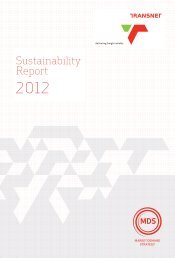Standard Operating Procedures for Container Terminals ... - Transnet
Standard Operating Procedures for Container Terminals ... - Transnet
Standard Operating Procedures for Container Terminals ... - Transnet
You also want an ePaper? Increase the reach of your titles
YUMPU automatically turns print PDFs into web optimized ePapers that Google loves.
9.6. The Customer alone is responsible <strong>for</strong> ensuring that all in<strong>for</strong>mation provided in<br />
the Pre-Advice is correct as the Terminal will not be accountable <strong>for</strong> any<br />
incorrect in<strong>for</strong>mation submitted to it and any delays and/or denial of entry to the<br />
Customer or its agents into the Terminal as a result thereof.<br />
9.7. Any in<strong>for</strong>mation submitted by or on behalf of the Customer, or in respect of the<br />
Customer’s cargo, by its employees, agents or contractors (such as the<br />
Customer’s depots, packers and authorised third parties), is deemed to have<br />
been provided by the Customer itself, unless the Customer can prove<br />
otherwise, and the Terminal Operator is absolved from any liability <strong>for</strong> the<br />
consequences of any act or omissions which may have occurred as a result of<br />
reliance having been placed on such in<strong>for</strong>mation.<br />
10. OPERATIONS<br />
10.1. The Terminal Operator must conduct all services rendered by it expeditiously in<br />
accordance with the Customer’s last timeous notification, and in a proper and<br />
workmanlike manner with good and sufficient cranes, labour, handling and other<br />
necessary equipment.<br />
10.2. The relevant computer system generated discharge and load lists or EDIFACT<br />
messages will constitute the Customer’s receipt <strong>for</strong> any container that is<br />
discharged or loaded onto a vessel.<br />
10.3. The tracking data (daily gate moves) supplied to the Customer in the Terminal<br />
<strong>Operating</strong> System constitutes the Customer’s receipt <strong>for</strong> any containers which<br />
enter or leave the Terminal by road or rail.<br />
10.4. Any person or entity, and its employees or agents, who enters the Terminal at<br />
the request and/or instruction of the Customer <strong>for</strong> any purpose is deemed to be<br />
the duly authorised agent of the Customer and any in<strong>for</strong>mation provided by<br />
such person or entity, its employees or agents, whether in writing or by means<br />
of data captured electronically, and whether the device or system <strong>for</strong> capturing<br />
such in<strong>for</strong>mation is provided by the Terminal Operator or not, is deemed to be<br />
in<strong>for</strong>mation provided by the Customer.<br />
10.5. The Terminal Operator must ensure that the Customer’s vessels are loaded and<br />
stowed in accordance with the Customer’s written or electronic instructions and<br />
the agreed stow plan timeously provided by the Customer or its agent.<br />
10.6. Within twelve (12) hours after the completion of all container working on a<br />
vessel during a call at the Port at which the Terminal is situated, the Terminal<br />
Operator must confirm to the Customer electronically all containers discharged<br />
SOPCT 01/04/2013 – 31/03/2014<br />
TRANSNET PORT TERMINALS, A DIVISION OF TRANSNET SOC Ltd Page 32 of 54

















